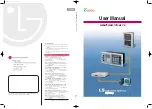
8
TB MRU3-2 12.00 E
4
Working principle
4.1
Analog circuits
The input voltages are galvanically insulated by the in-
put transformers. The noise signals caused by inductive
and capacitive coupling are supressed by an analog
R-C filter circuit.
The analog voltage signals are fed to the A/D-
converter of the microprocessor and transformed to
digital signals through Sample- and Hold- circuits. The
analog signals are sampled with a sampling frequency
of 16 x f
N
, namely, a sampling rate of 1.25 ms for
every measuring quantity, at 50 Hz.
4.2
Digital circuits
The essential part of the
MRU3-2
relay is a powerful
microcontroller. All of the operations, from the analog
digital conversion to the relay trip decision, are carried
out by the microcontroller digitally. The relay program
is located in an EPROM (Electrically-Programmable-
Read-Only-Memory). With this program the CPU of the
microcontroller calculates the three phase voltage in
order to detect a possible fault situation in the pro-
tected object.
For the calculation of the voltage value an efficient
digital filter based on the Fourier Transformation (DFFT -
Discrete Fast Fourier Transformation) is applied to sup-
press high frequency harmonics and d.c. components
caused by fault-induced transients or other system dis-
turbances. The microprocessor continuously compares
the measured values with the preset thresholds stored
in the parameter memory (EEPROM). If a fault occures
an alarm is given and after the set tripping delay has
elapsed, the corresponding trip relay is activated.
The relay setting values for all parameters are stored in
a parameter memory (EEPROM - Electrically Erasable
Programmable Read Only Memory), so that the actual
relay settings cannot be lost, even if the power supply
is interrupted.
The microprocessor is supervised by a built-in "watch-
dog" timer. In case of a failure the watchdog timer re-
sets the microprocessor and gives an alarm signal via
the output relay "self supervision".
4.3
Selection of star or delta
connection
All six connections of the input voltage transformers are
led to screw terminals. The nominal voltage of the de-
vice is equal to the nominal voltage of the input trans-
formers. Dependent on the application the input trans-
formers can be connected in either delta or star. The
connection for the phase-to-phase voltage is the delta
connection. In star connection the measuring voltage is
reduced by 1/ 3 . During parameter setting the con-
nection configuration either Y or
∆
has to be adjusted.
)!
)"
)#
)$
)%
)&
7
7 !
7!
Sec. winding of
mains V.T.
=
>
?
Figure 4.1: Input v.t.s in delta connection (D)
)!
)"
)#
)$
)%
)&
7
7
7!
Sec. winding of
mains V.T.
=
>
?
Figure 4.2: Input v.t.s in star connection (Y)
Содержание HighTECH MRU3-2
Страница 1: ...MRU3 2 Voltage relay with evaluation of symmetrical components...
Страница 36: ...36 TB MRU3 2 12 00 E...









































